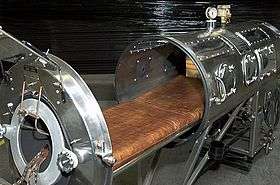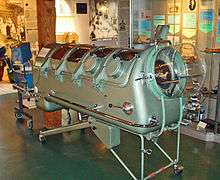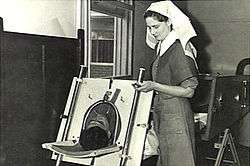Iron lung
A negative pressure ventilator, also known as iron lung (colloquialism) or pulmotor (generic trademark), is a mechanical respirator which enables a person to breathe on his or her own in a normal manner, when muscle control is lost, or the work of breathing exceeds the person's ability. Need for this treatment may result from certain diseases (e.g. polio, botulism) and certain poisons (e.g. barbiturates, tubocurarine).
| Negative pressure ventilator | |
|---|---|
 An Emerson iron lung. The patient lies within the chamber, which when sealed provides an effectively oscillating atmospheric pressure. This particular machine was donated to the Centers for Disease Control and Prevention Museum by the family of poliomyelitis patient Barton Hebert of Covington, Louisiana, who had used the device from the late 1950s until his death in 2003. | |
| ICD-9-CM | 93.99 |
| MeSH | D015919 |
Its use is largely obsolete in modern medicine, as superior breathing therapies have been developed, and due to the eradication of polio in the U.S..[1]
Examples of the device include both the Drinker respirator, the Emerson respirator, and the Both (or Emerson–Drinker) respirator. The negative form of pressure ventilation (decreasing surrounding pressure to induce inhalation then repressurizing to 1 bar (15 psi; 750 mmHg)) has been almost entirely superseded by positive pressure ventilation (forcing air into the lungs with a pressure greater than 1 bar then allowing the body to naturally exhale before repeating) or negative pressure cuirass ventilation
Method and use
Humans, like most mammals, breathe by negative pressure breathing:[2] the rib cage expands and the diaphragm contracts, expanding the chest cavity. This causes the pressure in the chest cavity to decrease, and the lungs expand to fill the space. This, in turn, causes the pressure of the air inside the lungs to decrease (it becomes negative, relative to the atmosphere), and air flows into the lungs from the atmosphere: inhalation. When the diaphragm relaxes, the reverse happens and the person exhales. If a person loses part or all of the ability to control the muscles involved, breathing becomes difficult or impossible.
Invention and early use

In 1670, English scientist John Mayow came up with the idea of external negative pressure ventilation. Mayow built a model consisting of bellows and a bladder to pull in and expel air.[3] The first negative pressure ventilator was described by Scottish physician John Dalziel in 1832. Successful use of similar devices was described a few years later. Early prototypes included a hand-operated bellows-driven "Spirophore" designed by Dr Woillez of Paris (1876),[4] and an airtight wooden box designed specifically for the treatment of polio by Dr Stueart of South Africa (1918). Stueart's box was sealed at the waist and shoulders with clay and powered by motor-driven bellows.[5] The first of these devices to be widely used however was developed in 1928 by Drinker and Shaw of the United States.[6] The iron lung, often referred to in the early days as the "Drinker respirator", was invented by Philip Drinker (1894–1972) and Louis Agassiz Shaw, Jr., professors of industrial hygiene at the Harvard School of Public Health.[7][8][9][10] The machine was powered by an electric motor with air pumps from two vacuum cleaners. The air pumps changed the pressure inside a rectangular, airtight metal box, pulling air in and out of the lungs.[11]
The first clinical use of the Drinker respirator on a human was on 12 October 1928, at the Boston Children's Hospital in the US.[8][12] The subject was an eight-year-old girl who was nearly dead as a result of respiratory failure due to polio.[10] Her dramatic recovery, within less than a minute of being placed in the chamber, helped popularize the new device.[9]
Boston manufacturer Warren E. Collins began production of the iron lung that year.[13][14] Although it was initially developed for the treatment of victims of coal gas poisoning, it was most famously used in the mid-20th century for the treatment of respiratory failure caused by poliomyelitis.[7]
Danish physiologist August Krogh, upon returning to Copenhagen in 1931 from a visit to New York where he saw the Drinker machine in use, constructed the first Danish respirator designed for clinical purposes. Krogh's device differed from Drinker's in that its motor was powered by water from the city pipelines. Krogh also made an infant respirator version.[15]
In 1931, John Haven Emerson (5 February 1906 – 4 February 1997) introduced an improved and less expensive iron lung.[16][17] The Emerson iron lung had a bed that could slide in and out of the cylinder as needed, and the tank had portal windows which allowed attendants to reach in and adjust limbs, sheets, or hot packs.[11] Drinker and Harvard University sued Emerson, claiming he had infringed on patent rights. Emerson defended himself by making the case that such lifesaving devices should be freely available to all.[11] Emerson also demonstrated that every aspect of Drinker's patents had been published or used by others at earlier times. Since an invention must be novel to be patentable, prior publication/use of the invention meant it was not novel and therefore unpatentable. Emerson won the case, and Drinker's patents were declared invalid.
The United Kingdom's first iron lung was designed in 1933 by Robert Henderson, an Aberdeen doctor. Henderson had seen a demonstration of the Drinker respirator in the early 1930s, and built a device of his own upon his return to Scotland. Four weeks after its construction, the Henderson respirator was used to save the life of a 10-year-old boy from New Deer, Aberdeenshire, who was suffering from poliomyelitis. Despite this success, Henderson was reprimanded for secretly using hospital facilities to build the machine.[18][19]
Both respirator

The Both respirator, a negative pressure ventilator, was invented in 1937 when Australia's epidemic of poliomyelitis created an immediate need for more ventilating machines to compensate for respiratory paralysis. Although the Drinker model was effective and saved lives, its widespread use was hindered by the fact that the machines were very large, heavy (about 750 lbs), bulky, and expensive. In the US, an adult machine cost about $2000 in 1930, and £2000 delivered to Melbourne in 1936. The cost in Europe in the mid-1950s was around £1500. Consequently, there were few of the Drinker devices in Australia and Europe.[20]
The South Australia Health Department asked Adelaide brothers Edward and Don Both to create an inexpensive "iron lung".[21] Biomedical engineer Edward Both designed and developed a cabinet respirator made of plywood that worked similarly to the Drinker device, with the addition of a bi-valved design which allowed temporary access to the patient's body.[20] Far cheaper to make (only £100) than the Drinker machine, the Both Respirator also weighed less and could be constructed and transported more quickly.[20][22] Such was the demand for the machines that they were often used by patients within an hour of production.[23]

Visiting London in 1938 during another polio epidemic, Both produced additional respirators there which attracted the attention of William Morris (Lord Nuffield), a British motor manufacturer and philanthropist. Nuffield, intrigued by the design, financed the production of approximately 1700 machines at his car factory in Cowley, and donated them to hospitals throughout all parts of Britain and the British Empire.[23] Soon, the Both-Nuffield respirators were able to be produced by the thousand at about one-thirteenth the cost of the American design.[21] By the early 1950s, there were over 700 Both-Nuffield iron lungs in the United Kingdom, but only 50 Drinker devices.[24]
Modern usage

Rows of iron lungs filled hospital wards at the height of the polio outbreaks of the 1940s and 1950s, helping children, and some adults, with bulbar polio and bulbospinal polio. A polio patient with a paralyzed diaphragm would typically spend two weeks inside an iron lung while recovering.[25]
Polio vaccination programs have virtually eradicated new cases of poliomyelitis in the developed world. Because of this, and the development of modern ventilators, and widespread use of tracheal intubation and tracheotomy, the iron lung has mostly disappeared from modern medicine. In 1959, there were 1,200 people using tank respirators in the United States, but by 2004 there were only 39.[26] By 2014, there were only 10 people left with an iron lung.[27]
Positive pressure ventilation systems are now more common than negative pressure systems. Positive pressure ventilators work by blowing air into the patient's lungs via intubation through the airway; they were used for the first time in Blegdams Hospital, Copenhagen, Denmark, during a polio outbreak in 1952.[28][29] It proved a success and soon superseded the iron lung throughout Europe.
The iron lung now has a marginal place in modern respiratory therapy. Most patients with paralysis of the breathing muscles use modern mechanical ventilators that push air into the airway with positive pressure. These are generally efficacious and have the advantage of not restricting patients' movements or caregivers' ability to examine the patients as significantly as an iron lung does. However, negative pressure ventilation is a truer approximation of normal physiological breathing and results in more normal distribution of air in the lungs. It may also be preferable in certain rare conditions, such as central hypoventilation syndrome, in which failure of the medullary respiratory centers at the base of the brain results in patients having no autonomic control of breathing. At least one reported polio patient, Dianne Odell, had a spinal deformity that caused the use of mechanical ventilators to be contraindicated.[30] There are patients who today still use the older machines, often in their homes, despite the occasional difficulty of finding the various replacement parts.[31] Joan Headley of Post-Polio Health International said that as of May 28, 2008, there were about 30 patients in the U.S. still using an iron lung.[32] That figure may be inaccurately low; Houston alone had 19 iron lung patients living at home in 2008.[33] Martha Mason of Lattimore, North Carolina, died on May 4, 2009, after spending 60 of her 72 years in an iron lung.[34]
On 30 October 2009, June Middleton of Melbourne, Australia, who had been entered in the Guinness Book of Records as the person who spent the longest time in an iron lung, died aged 83, having spent more than 60 years in her iron lung.[35]
In 2013, the Post-Polio Health International (PHI) organizations estimated that there were only six to eight iron lung users in the United States; as of 2017 its executive director knew of none. Press reports then emerged, however, of at least three (perhaps the last three)[36] users of such devices,[37] sparking interest amongst those in the makerspace community such as Naomi Wu[38] in the manufacture of the obsolete components, particularly the gaskets.[39] Another is retired lawyer Paul Alexander, 72, of Dallas.[40]
Biphasic cuirass ventilation
Biphasic cuirass ventilation (BCV) is a modern development of the iron lung, consisting of a wearable rigid upper-body shell (a cuirass) which functions as a negative pressure ventilator. The ventilation is biphasic because the cuirass is attached to a pump which actively controls both the inspiratory and expiratory phases of the respiratory cycle. This method is a modern improvement of 'negative pressure ventilation' (NPV), which could only control inspiratory breathing, relying on passive recoil for exhalation. BCV was developed by Dr Zamir Hayek, a pioneer in the field of assisted ventilation. Some of Dr Hayek's previous inventions include the Hayek Oscillator, an early form of the technology.
References
- "America's last iron lung users on their lives spent inside obsolete ventilators | The Independent". 2017-11-22.
- "Gas Exchange in Humans". Archived from the original on 2009-04-23. Retrieved 2011-07-01.
- Schlager, Neil (2000). Science and Its Times: Understanding the Social Significance of Scientific Discovery, Vol. 6: 1900-1950. Farmington Hills, Michigan: Gale. p. 348. ISBN 978-0787639389.
- Emerson, John H (July 1998). "Some Reflections on Iron Lungs and Other Inventions" (PDF). Respiratory Care. 43 (7): 577. Archived from the original on 24 March 2006. Retrieved 12 October 2016.CS1 maint: BOT: original-url status unknown (link)
- Gould, Tony (1997). A Summer Plague: Polio and Its Survivors. New Haven: Yale University Press. p. 90. ISBN 978-0300072761.
- Laurie, Gini (2002). "Ventilator users, home care, and independent living: a historical perspective". In Gilgoff, Irene S. (ed.). Breath of Life: The Role of the Ventilator in Managing Life-Threatening Illnesses. Lanham, Maryland: Scarecrow Press, Inc. pp. 161–201. ISBN 978-0-8108-3488-0.
- Sherwood, RJ (1973). "Obituaries: Philip Drinker 1894–1972". The Annals of Occupational Hygiene. 16 (1): 93–4. doi:10.1093/annhyg/16.1.93.
- Gorham, J (1979). "A medical triumph: the iron lung". Respiratory Therapy. 9 (1): 71–3. PMID 10297356.
- "2010-2011 Student Handbook" (PDF). Cambridge, Massachusetts: The Harvard Education and Research Center for Occupational Safety and Health. 2010. Retrieved 2011-07-02.
- P.C. Rossin College of Engineering and Applied Science (2011). "Philip Drinker '17". Distinguished Alumni: Great Talents & Bright Minds. Bethlehem, Pennsylvania: Lehigh University. Archived from the original on 2011-06-15. Retrieved 2011-07-01.
- Kenneth E. Behring Center (2011). "The iron lung and other equipment". Whatever happened to polio?. Washington, DC: National Museum of American History. Retrieved 2011-07-02.
- "Today in History: Iron Lung Used for the First Time (1928)". Tebyan.net. Retrieved 2013-11-14.
- Julie K. Silver; Daniel J. Wilson (2007). Polio Voices. Santa Barbara: Praeger Publishers. p. 141.
- "Artificial Lung on Wheels Prove Life Saver" Popular Mechanics, December 1930 photo of earliest production units from Boston
- Kirby, Richard R. (1985). Mechanical Ventilation. New York: Churchill Livingstone. p. 9. ISBN 978-0443080630.
- Geddes, LA (2007). "The history of artificial respiration". IEEE Engineering in Medicine and Biology Magazine. 26 (6): 38–41. doi:10.1109/EMB.2007.907081. PMID 18189086.
- "Iron Lung". National Museum of American History. Retrieved 2011-07-01.
- Wills, Elspeth (2002). Scottish Firsts: A Celebration of Innovation and Achievement. Edinburgh: Mainstream Publishing. pp. 51–2. ISBN 978-1840186116.
- Thomas, Campbell (15 February 2000). "Dr Robert Henderson". The Herald. Retrieved 10 March 2013.
- Trubuhovich, Ronald V. (2006). "Notable Australian contributions to the management of ventilatory failure of acute poliomyelitis". Critical Care and Resuscitation. 8 (4): 383–5.
- Healey, John (1998). "The Both Brothers and the 'Iron Lung'". South Australian Medical Heritage Society Inc. Retrieved 10 March 2013.
- "Memories of polio and those who wrestled with it". The Sydney Morning Herald. 2004-12-07. Retrieved 2013-03-10.
- Langmore, Diane, ed. (2009). Australian Dictionary of Biography: Volume 17 1981-1990 A-K. Carlton, Victoria: Melbourne University Publishing. p. 129. ISBN 978-0522853827.
- Lawrence, Ghislaine (2002-02-23). "The Smith-Clarke Respirator". The Lancet. 359 (9307): 716. doi:10.1016/s0140-6736(02)07819-4. PMID 11879908.
- http://amhistory.si.edu/polio/howpolio/ironlung.htm
https://www.theatlantic.com/national/archive/2012/01/what-america-looked-like-polio-children-paralyzed-in-iron-lungs/251098/ - "NMAH - Polio: The Iron Lung and Other Equipment". amhistory.si.edu.
- http://www.washingtontimes.com, The Washington Times. "North Texan one of 10 still living in iron lung".
- Louise Reisner-Sénélar (2009). "The Danish anaesthesiologist Björn Ibsen a pioneer of long-term ventilation on the upper airways". Retrieved 2011-07-01.
- Wackers, Ger (1994). "Chapter 4: Theaters of truth and competence. Intermittent positive pressure respiration during the 1952 polio-epidemic in Copenhagen". Archived from the original on 2007-12-23. Retrieved 2011-07-01. Missing or empty
|title=(help) - "Power failure kills iron lung lady". The Sydney Morning Herald. 2008-05-29. Retrieved 2011-07-01.
- "60 years in an iron lung: US polio survivor worries about new global threat".
- "Woman dies after life spent in iron lung". May 28, 2008. Archived from the original on October 22, 2008. Retrieved 2011-07-01.
- Lauran Neergaard (2009-01-13). "Emergency officials struggle to find those on life-support during power outages". Retrieved 2014-01-01.
- Fox, Margalit (2009-05-10). "Martha Mason, Who Wrote Book About Her Decades in an Iron Lung, Dies at 71". The New York Times. Retrieved 2011-07-01.
- "Dead after 60 years in iron lung". The Sydney Morning Herald. 2009-11-01. Retrieved 2011-07-01.
- MAZZIOTTA, JULIE (August 21, 2018). "Polio Survivor, 82, Is One of the Last 3 People in the U.S. to Use an Iron Lung". People Magazine.
- Brown, Jennings (2017-11-20). "The Last of the Iron Lungs". Gizmodo. Retrieved 2017-11-25.
- Lewin, Day (2017-11-25). "A Callout: Parts for an Iron Lung". Hackaday. Retrieved 2017-11-25.
- Naomi Wu [@reaksexycyborg] (2017-11-23). "Via @NireBryce- we've got a nice old lady running out of collars for her iron lung. Lot of 💩 going on in the world we can't do anything about- but this seems 100% doable. @hackaday, @make, textile tech folks- any ideas? From gizmodo.com/the-last-of-the-iron-lungs-1819079169 …" (Tweet) – via Twitter.
- "Living inside a canister: this polio survivor is one of few people left using iron lung". Stuff (Fairfax). 1 June 2018.
Further reading
- Emerson, JH; Loynes, JA (1978). The evolution of iron lungs: respirators of the body-encasing type. Cambridge, Massachusetts: J.H. Emerson Company.
- Martha Mason, a polio survivor, penned a best-selling memoir, Breath, about her life inside an iron lung.
- Margaret Atwood mentions an iron lung in her book Cat's Eye
- Peg Kehret mentions the use of an iron lung in her autobiographical book, Small Steps: The Year I Got Polio
- Elizabeth Berg shares a fictionalization of the true story of Pat Raming, the first woman to give birth to baby while in an iron lung, in her book, We are all Welcome Here. 2006.
- Respiration Without Breathing - about the Thunberg "barospirator" built by John Emerson.
External links
| Wikimedia Commons has media related to Iron lungs. |
- "Iron Lung." Claude Moore Health Sciences Library, University of Virginia
- Both respirator at the Powerhouse Museum